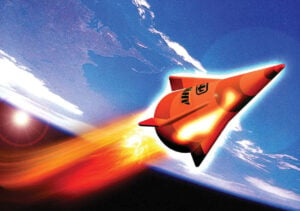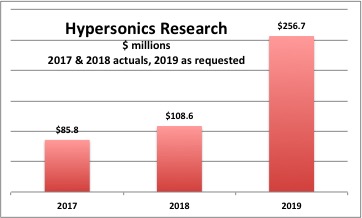By COLIN CLARK
 The great majority of the chatter one hears from the US military about hypersonic missiles is how to spot them, track them, and shoot them down. But at the Hudson Institute today, a gathering of experts on hypersonic weaponry and missile defense all agreed that, if the US invests solely in defense, we’ll be falling for what military theorists call a cost-imposition strategy: I spend x on a weapon in hope of scaring you into spending many times x to counter it.
The great majority of the chatter one hears from the US military about hypersonic missiles is how to spot them, track them, and shoot them down. But at the Hudson Institute today, a gathering of experts on hypersonic weaponry and missile defense all agreed that, if the US invests solely in defense, we’ll be falling for what military theorists call a cost-imposition strategy: I spend x on a weapon in hope of scaring you into spending many times x to counter it.In the case of hypersonics, “the best defense is a good offense here,” said Roger Zakheim, Washington director of the Ronald Reagan Presidential Foundation, with his fellow panelists nodding agreement.
China’s hypersonics work, “has all the markings of a cost imposition strategy,” added Thomas Karako, a top missile defense expert at the Center for Strategic and International Studies (CSIS).
The problem is physics: It’s much easier to build a missile that can hit a ship, base, or city, which are big and slow, than to build a missile to shoot down other missiles, which are small and fast. So each defensive missile generally costs more than the offensive ones it’s shooting down, and you need at least as many interceptors as you expect attackers. Laser weapons may someday break this equation, since they offer infinite reloads and speed-of-light reaction times. But if you have to kill a missile with another missile, the best time to hit the enemy weapons is before they launch, which they’re not moving a thousand miles an hour. (The jargon for this tactic is “left of launch.”)
So what weapons mix would be a potent one to counter Chinese hypersonics? Karako said we could try turning the cost-imposition tables: If the US gets its own hypersonic weapons, that could force China “to spend a really sizable part of their budget on air defense — great. Every bit they spend on air defenses means they have less money to spend on strike forces.”
 I spoke with some of the panelists after their presentations and asked if China would be happy about the US pursuing substantial missile defense efforts against hypersonic weapons, instead of spending on offensive weapons. After long… pauses… I was told they couldn’t really comment on that. When I asked again about what weapons would be effective against hypersonics, two people told me the answers would mostly be classified.
I spoke with some of the panelists after their presentations and asked if China would be happy about the US pursuing substantial missile defense efforts against hypersonic weapons, instead of spending on offensive weapons. After long… pauses… I was told they couldn’t really comment on that. When I asked again about what weapons would be effective against hypersonics, two people told me the answers would mostly be classified.We’ll see in tomorrow’s fiscal 2020 budget presentations how much money has been apportioned for hypersonics research and for missile defense to counter the threat.
